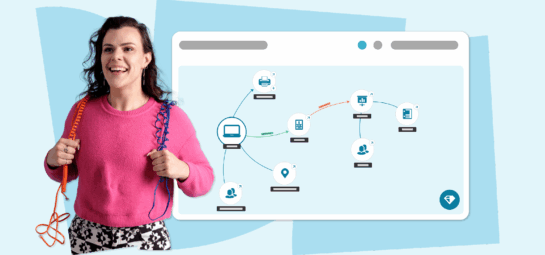Understanding service desk tiers: A guide to Tier 0 through Tier 3

When service desks are overwhelmed, the symptoms show up fast: support tickets stack up, response times slow down, and employee satisfaction starts to dip. IT teams are left scrambling just to keep the lights on, with little room for proactive improvements or strategic projects. That probably sounds familiar.
The problem often isn’t with the team — it’s with the structure. That’s where tiered support models come in. These frameworks help organizations sort and solve requests more efficiently by matching the right level of expertise to each issue. From Tier 0’s automated self-service to Tier 3’s advanced technical troubleshooting, each level plays a unique role in managing demand.
In this blog, you’ll find service desk tiers explained in clear, practical terms. We’ll cover what each tier does, examples of common tickets, how escalation should flow, and ways to optimize resources across all levels. You’ll also learn how TOPdesk supports tiered service strategies through features like dynamic ticket routing and integrated knowledge bases.
What are service desk tiers?
Service desk tiers are structured levels of IT support, typically ranging from Tier 0 to Tier 3. Each tier represents a different depth of expertise and intervention — not a rigid hierarchy, but a way to streamline support operations.
Understanding IT support tiers means looking at how organizations handle everything from simple password resets to complex system failures. The goal is to route each request to the team best equipped to handle it. This improves response times, prevents burnout, and gives support staff the clarity they need to do their jobs effectively.
Tiered support models are especially useful as teams scale. They provide a framework for training, staffing, and ticket management. By assigning roles and expectations to each tier, companies can avoid duplication of work and make smarter use of specialized skills. This strategic approach helps IT teams grow sustainably while delivering consistent service across the board.
In short, service tiers are less about separating people and more about connecting requests with the right expertise — which is where real efficiency begins.
Download our free guide to structuring IT support with clear, scalable tiers.
Tier 0 support — the self-service advantage
Tier 0 support is all about empowering users to solve common problems on their own — without needing to submit a ticket or wait for assistance. This tier includes tools like searchable knowledge bases, how-to videos, AI-powered chatbots, and user-friendly self-service portals. When done right, Tier 0 becomes the fastest, most scalable way to handle high-volume, repetitive issues.
Think of Tier 0 as the digital concierge of your service desk — always available, always ready. It’s especially effective when automation is paired with well-structured, easy-to-understand content. The better the resource, the more likely users will find the answers they need without giving up in frustration or escalating prematurely.
Here are a few examples of issues commonly addressed at Tier 0:
- Resetting a forgotten password.
- Connecting to a printer or shared drive.
- Finding a software installation guide.
- Checking VPN setup instructions.
- Accessing a troubleshooting article for common error messages.
By resolving these types of requests without human intervention, teams not only save time and money, but also create a better user experience. People don’t want to wait — they want answers. And Tier 0 delivers.
TOPdesk’s Self-Service Portal is built for this exact scenario. It connects users with the right solution instantly, guiding them through workflows and articles tailored to their issue. It also supports accurate incident classification the moment a request is created, ensuring that escalated tickets are already well-organized and informative when they reach a human agent.
Download our Self-Service e-book to enhance your Tier 0 support strategies.
Tier 1 support — the frontline of human help
When self-service isn’t enough, Tier 1 support is where people turn. This frontline team acts as the first human touchpoint in your IT support structure. These generalists handle a wide variety of issues and rely on strong communication skills, empathy, and a working knowledge of common systems to keep the operation running smoothly.
Tier 1 staff don’t necessarily need deep technical expertise, but they do need the ability to assess, triage, and either solve or escalate issues efficiently. The goal is fast, effective resolution — or gathering just enough detail to ensure a smooth handoff.
Examples of common Tier 1 tickets include:
- Trouble accessing shared folders.
- Email sync issues on mobile devices.
- Basic Wi-Fi connectivity problems.
- Software installation permission requests.
- Slow computer performance troubleshooting.
Because Tier 1 handles a high volume of requests with wide variability, incident classification plays a big role here. Categorizing issues accurately from the outset helps streamline routing and avoids sending unnecessary tickets to higher tiers. A well-trained Tier 1 team, supported by smart tools like TOPdesk, can resolve a significant percentage of tickets before escalation is even needed — improving satisfaction for users and reducing workload across the board.
Explore our Knowledge Management Guide to empower your Tier 1 support team.
Tier 2 support — specialized and system-focused
Tier 2 support is where requests get more technical. Staffed by specialists or experienced technicians, this tier handles tickets that require in-depth troubleshooting, system-level access, or familiarity with departmental workflows. These team members are typically assigned based on their expertise in certain tools, networks, or business functions.
Tier 2 professionals deal with tickets that couldn’t be resolved at Tier 1, either due to complexity or required access. They often collaborate directly with end users to replicate issues, gather diagnostic data, and make targeted changes.
Common Tier 2 responsibilities include:
- Resolving software compatibility issues.
- Adjusting user permissions across systems.
- Troubleshooting network configuration errors.
- Addressing hardware performance issues.
- Handling requests involving legacy systems.
At this stage, ticket escalation becomes more nuanced. Simply passing the problem up the chain isn’t enough — context, categorization, and impact all matter. TOPdesk supports this by enabling automated workflows based on incident classification and urgency, ensuring that Tier 2 receives tickets that are truly within their scope and arrive with all the needed background.
Tier 2’s role is crucial for maintaining performance and preventing unnecessary escalations to Tier 3. With the right tools and process in place, this tier becomes the technical backbone of your support model — capable of resolving sophisticated issues quickly while reinforcing lower-tier operations.
Tier 3 technical support — deep expertise for complex problems
Tier 3 technical support handles the toughest challenges in the IT ecosystem. Reserved for issues that require the highest level of technical expertise, this tier includes internal developers, infrastructure architects, and sometimes even external vendors or software providers. It’s a small group, but an essential one.
Tier 3 is where your organization goes for problem-solving that involves architecture, backend systems, or complex integrations. These professionals aren’t just responding to tickets — they’re often identifying root causes, applying long-term fixes, and working behind the scenes to prevent recurring issues.
Types of requests best suited for Tier 3 technical support include:
- Root cause analysis for recurring software crashes.
- Recovery of lost data after a system failure.
- Addressing security vulnerabilities after an audit.
- Diagnosing system-wide latency or downtime issues.
- Modifying custom-built enterprise applications.
Because the time and expertise required at this level is significant, it’s critical to minimize unnecessary traffic to Tier 3. That’s why an effective tiered support model is so important: It enables earlier tiers to resolve what they can and only pass along truly advanced or urgent issues.
TOPdesk supports this layered approach by helping organizations structure their workflows and routing rules so that Tier 3 resources are preserved for the work that truly needs their attention. This means less firefighting, more long-term impact, and, ultimately, a more resilient support operation.
How ticket escalation should flow across tiers
For tiered support to work, there needs to be a clear and efficient ticket escalation process. Tickets should move through tiers based on specific triggers — like request complexity, business impact, or failed resolution attempts — not just because someone wants a faster answer.
The best workflows include:
- Defined escalation rules tied to incident categories or SLAs.
- Context-rich handoffs between tiers (no starting over).
- Ownership visibility at every stage.
TOPdesk makes this process smooth with customizable TOPdesk ticket routing. Whether a ticket needs to be reassigned to Facilities, escalated to Tier 3, or flagged for Change Management, routing rules ensure it gets to the right place without delay. This keeps things moving — and keeps users informed at every step.
Optimizing resources across IT support tiers
Once you understand your IT support tiers, the next step is using them wisely. The goal is not just faster resolutions — it’s to build a support structure that grows with your business.
Start with Tier 0: Look for repeatable issues you can automate or address with knowledge base articles. Then, train your Tier 1 team to handle common scenarios confidently, and make sure they know when to escalate. Finally, empower Tier 2 and 3 teams by shielding them from avoidable tasks and giving them the tools they need to collaborate effectively.
This model only works if knowledge flows both ways. When Tier 3 solves a tricky issue, that insight should inform Tier 2 documentation or Tier 1 scripts. That’s where platforms like TOPdesk shine — offering integrated support environments where teams can share information, track trends, and continuously improve together.
See how TOPdesk’s features support your ITSM strategy.
Key takeaways
- Tiered service desk models streamline IT support by assigning the right level of expertise to each issue, improving resolution times and reducing burnout.
- Each support tier plays a distinct role, from Tier 0’s automated self-service tools to Tier 3’s advanced troubleshooting by technical experts.
- Efficient ticket escalation and smart routing are critical, ensuring complex issues reach higher tiers only when necessary and with proper context.
- TOPdesk enhances tiered support through dynamic ticket routing, integrated knowledge bases, and collaboration tools that enable scalable, proactive IT service management.
Putting service desk tiers into action
Having your service desk tiers explained is just the beginning. Understanding how each level works — and how to connect them — can help you build a more efficient, scalable, and user-friendly support model.
With the right structure in place, your IT team can stop firefighting and start focusing on long-term value.
Discover comprehensive strategies in our Best Practice Service Management (BPSM) e-book to optimize your Tier 2 and Tier 3 support.
Inspire others, share this blog


